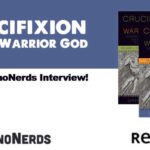We run our website the way we wished the whole internet worked: we provide high quality original content with no ads. We are funded solely by your direct support. Please consider supporting this project.

How Classical Theology Gets It Wrong
Classical theology has conceived of God as altogether necessary, simple, timeless, unchanging and unknowable. This view of God requires us to conclude that biblical images of God do not reflect the way God truly is insofar as they portray God moving in sequence with humans from the past into the future, for this obviously conflicts with God’s timelessness. Yet, no one disputes that most, if not all, biblical depictions of God portray God in just this fashion. The same holds true of biblical depictions of God being impacted by, and responding to, human activity, or of God changing his plans in light of actions that humans take. Moreover, those who espouse this classical view of God, interpret all depictions of God grieving, getting angry, being frustrated, or suffering out of love for wayward humans as failing to reflect God’s true nature.
In fact, some have gone so far as to claim that biblical depictions fail to reflect the way God truly is insofar as they simply portray the God-world relationship as something that is real to both God and the world. I challenge readers to find a biblical image of God that depicts the God-world relationship as other than real to both God and the world.
When biblical authors depict God’s relationship to the world in any of these ways, they conflict with the classical conception of God. According to classical theists, these sorts of depictions must therefore be interpreted as accommodations, anthropomorphisms, and/or as examples of Scripture speaking in terms of how God appears to us rather than in terms of how God actually is. Portraits of God with these dynamic and relational characteristics—which is true to some degree for every divine portrait in Scripture—must be judged to be falling short of the truth.
In fact, some have argued that to interpret biblical depictions of God dynamically interacting with his people as reflecting the way God truly is borders on idolatry. For example, Herbert McCabe argues that, “the God spoken of by those who insist on God’s participation in the history of his people, sharing their experiences, their sufferings and triumphs, is perilously like one of the gods” (God Matters, 42).
By disallowing the depictions of God’s sequential, dynamic, personal, mutually influential relationship with his people to reflect the way God truly is, classical theology has actually undermined the most distinctive and most distinctly beautiful dimension of the Bible’s portrait of God.
We should ground all our thinking about God, from start to finish, in the beautiful revelation of God in the crucified Christ as witnessed to in Scripture. And when we ground our reflections in this starting point, it makes all the difference in the world!
If we anchored all of our thinking in the cross, would it ever occur to us to suspect that God is altogether immutable or “above” experiencing sequences? The Word was made flesh and became our sin and our curse! If we trust this revelation, God apparently can change and God apparently does experience a “before” and “after”! Along the same lines, if our complete trust was in this supreme revelation and not in our own reasoning processes, would we ever suspect that God cannot be impacted by what transpires in the world or that God can’t suffer? If we trust that the one who hung in agony on the cross reveals God’s true nature, would we not rather conclude that God is profoundly impacted by what transpires in the world and is capable of the greatest suffering imaginable? And finally, if all our reflections about God began with the cross, I submit that the very last thing we would ever suspect is that the relationship between God and the world is real to us but not to God!
Photo credit: Josh Felise via Unsplash
Category: General
Tags: Bible, Classical Theism, Cruciform Theology, Philosophy
Topics: Attributes and Character
Related Reading

Did Yahweh Crush His Son?
Though Isaiah was probably referring to the nation of Israel as Yahweh’s “suffering servant” when these words were penned, the NT authors as well as other early church fathers interpreted this servant to be a prophetic reference to Christ. Speaking proleptically, Isaiah declares that this suffering servant was “punished” and “stricken by God” (Isa 53:4,…

Podcast: Crucifixion of the Warrior God—The MennoNerds Interview
Paul Walker begins his interview with Greg about Crucifixion of the Warrior God. Paul Walker can be found at MennoNerds. Follow MennoNerds on Twitter. PART ONE: http://traffic.libsyn.com/askgregboyd/Episode_0131.mp3 PART TWO: http://traffic.libsyn.com/askgregboyd/Episode_0132.mp3 PART THREE: http://traffic.libsyn.com/askgregboyd/Episode_0133.mp3 PART FOUR: http://traffic.libsyn.com/askgregboyd/Episode_0134.mp3 PART FIVE: http://traffic.libsyn.com/askgregboyd/Episode_0135.mp3 PART SIX: http://traffic.libsyn.com/askgregboyd/Episode_0136.mp3 PART SEVEN: http://traffic.libsyn.com/askgregboyd/Episode_0137.mp3 PART EIGHT: http://traffic.libsyn.com/askgregboyd/Episode_0138.mp3 PART NINE: http://traffic.libsyn.com/askgregboyd/Episode_0139.mp3 PART TEN: http://traffic.libsyn.com/askgregboyd/Episode_0140.mp3 PART…

One Word
While I’ve lately been pretty distracted finishing up Benefit of the Doubt (Baker, 2013), my goal is to sprinkle in posts that comment on the distinctive commitments of ReKnew a couple of times a week. I’m presently sharing some thoughts on the second conviction of ReKnew, which is that Jesus Christ is the full and…

The Extremity of God’s Love
In response to questions he has received about whether Jesus was actually separated from the Father on the cross, Greg fleshes out his perspective on this. The love that unites the Trinity is the very same love that resulted in the separation of the Father from the Son. This separation actually expresses the great love…

Podcast: If the Biblical Prophecies are Flawed, Aren’t Those Prophets ALL False Prophets?
If you want to hear Greg sweat, listen to him work through this really really good question. http://traffic.libsyn.com/askgregboyd/Episode_0200.mp3 Photo by Rex Boggs

What the Cross Tells Us About God
Whether we’re talking about our relationship with God or with other people, the quality of the relationship can never go beyond the level of trust the relating parties have in each other’s character. We cannot be rightly related to God, therefore, except insofar as we embrace a trustworthy picture of him. To the extent that…
